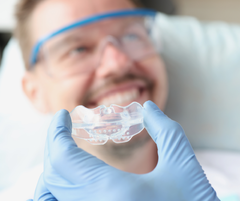Oral health is an essential part of our overall well-being, and protecting your teeth is crucial in maintaining a healthy and beautiful smile. One essential tool in safeguarding your oral health is the mouthguard.
What is a mouthguard?
A mouthguard is a protective device worn over the teeth and gums cushioning them and protecting them from injury. Typically made of flexible material, such as rubber, mouthguards absorb and redistribute the force of impact that could otherwise cause harm to the teeth, gums, lips, and jaw.
Types of mouthguards
Custom-made mouthguards
Custom-fitted mouthguards are made by dental professionals based on impressions of an individual's teeth. This ensures a snug fit, maximising protection and comfort. Though more expensive than other options, custom mouthguards offer the most comfort and the best protection. These mouthguards are recommended for adults and adolescents who no longer have any baby teeth.

Boil and bite mouthguards
Boil and bite mouthguards are pre-formed u-shaped plastic trays and are available from most sports stores. You heat the guard in hot water, softening the plastic, and then bite into it to shape it around your teeth. You can use your fingers and tongue to help mould it for a better fit.
These mouthguards may be used by younger children who still have some baby teeth. It is recommended to talk to your dentist for advice on how to achieve the best fit.
When should you wear a mouthguard?
- Sports Protection: Mouthguards should be worn when playing any sport where there is a risk of impact to the face or mouth such as rugby, GAA football or field hockey. Non-contact sports like gymnastics, skateboarding or mountain biking may also pose a risk of injury to the mouth, so it is recommended to wear a mouthguard to reduce the possibility of trauma.
- Night Guards: Some individuals suffer from bruxism, a condition characterised by teeth grinding or clenching during sleep. Mouthguards known as night guards are designed to protect teeth from the damaging effects of this involuntary habit, preventing wear and tear, and alleviating associated discomfort.
- Orthodontic Use: Mouthguards can also be used in orthodontics to protect braces and other dental appliances. They provide an additional layer of protection against impact and help prevent injuries caused by the braces themselves. If you wear braces and need a mouthguard you should speak to your orthodontist.

Caring for your mouthguard
Just as you maintain your oral hygiene by cleaning your teeth daily to get rid of bacteria, the same attention is needed for your mouthguard after each use. After wearing it, brush the guard using a toothbrush and toothpaste. Thoroughly rinse it, allowing it to dry completely before storing it in a well-ventilated case. On a weekly or bi-weekly basis, place it in an antimicrobial solution like diluted mouthwash or denture cleaner. Again, make sure it’s completely dry before storing it. Regularly inspect the mouthguard for any cracks or rough edges to prevent irritation to your gums and the build-up of bacteria.
Things to consider
A mouthguard should fit you properly so it can give you the best possible protection.
Remember, a mouthguard
- should not make you gag
- should not affect your speech
- should not hinder your breathing
- should remain securely in place without you needing to bite or clench your teeth
- should cover your teeth and part of your gums to reduce the risk of cuts and protect tooth roots.
- should be comfortable.